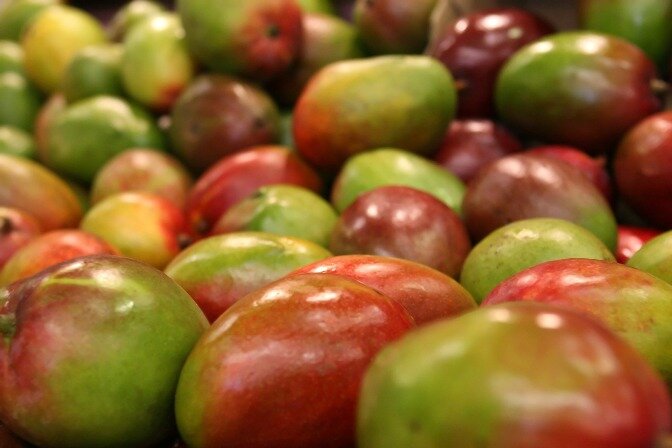
Flamboyant, flavor-filled and healthy, the mango is good in a wide variety of recipes, not just in salads or chutney. This fruit is making its way to tables all over the world. It packs in the nutrition in the form of vitamins A, C, D and E. Its antioxidants help skin resist the damaging effects of sun and its pectin, fiber and Vitamin C helps lower serum cholesterol levels. The mango is such a familiar part of South Africa that a South African airline named itself after the fruit and painted its aircraft a brilliant orange-red hue like that of the ripened mango.
The foothills of the Himalayas near the Bangladesh border with India are the natural habitat of the mango tree(Mangiferaindica). Its cultivation in northern India happened a very long time ago. A story from Buddhist tradition describes a faithful devotee of the Buddha giving him a whole orchard of mangoes so he could rest in their shade. Turkish poet Amir Khusrow wrote of the mango fruit in India as long ago as the mid-1300s, so we know it was being harvested there at that time in history.
Historians are uncertain about when the mango left India. It arrived in South Africa when Jan van Riebeeck planted trees at the Cape of Good Hope around 1653. The winter cold killed them.In the 1600sseeds were also planted inKwaZulu Natal. In this warmer climate, .the seeds survived and became mature trees. However, commercial production had to wait untilthe 1920s when successful growersin the Mpumalanga Province sold their produce. Production increased even more with Florida cultivars in the 1950s.Now, mangoes are a staple fruit. The northeast is still prime mango grower country.The best time for planting nursery trees is in late August through September.

This individual mango is not ripe.
Cousins of the mango are the Marula tree native to southern Africa and the poison ivy vine native to North America. Some persons who have a contact dermatitis reaction to poison ivy may have a reaction to mango peel, mango leaves and mango bark and sap since they, like the poison ivy leaves, contain urushiol, This does not occur in the fruit or its juice.If you havea known sensitivity to poison ivy, wash your skin thoroughly with soap and water as soon as possible if you have handled mango leaves, sap and bark. Don’t wait! If you have an allergy to latex, you may have a reaction to mango fruit, particularly if green, since green ones contain anacardic acid
Ripe mangoes can be eaten plain, can be made into desserts like mango ice cream or made into chutney or pickles. They are popular in my home as dried fruit slices. They are good added to ice cream. I like mango salsa with my Mexican food, since it adds that little bit of sweetness to counteract the hot chilies, and I especially like it in sandwiches!
Mango Sandwiches Ungrilled or grilled, try them both ways!

A mango and camembert sandwich even better grilled.
Four slices of wheat bread
6 mango slices
6 grams dried cranberries
12 grams butter or margarine
125 grams Camembert cheese, thinly sliced
Arugula or other greens of choice
Chicken breast slices (optional)
Butter two slices of bread, each on one side only. Set the bread, buttered-side down, on a plate. Spread the sliced mangoes, cranberriesand optional chicken on the unbuttered sides. Top the bread with the cheese. Spread one side of the other two bread slices with butter and set them on top of thecheese, unbuttered side down. Prepare anon-stick skillet, medium heat. Cook for three to four minutes per side, or until golden brown and the cheese is melted. Add greens.
Mango Ice Cream
For each two liter container of softened vanilla ice cream, add 500 milliliters of ripe mango pulp. Mix well and freeze again.
